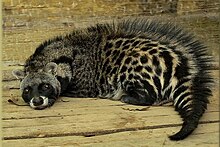African civet[1]

African civetConservation status

Least Concern (IUCN 3.1)[2]
Scientific classificationKingdom:AnimaliaPhylum:ChordataClass:MammaliaOrder:CarnivoraFamily:ViverridaeSubfamily:ViverrinaeGenus:Civettictis
Pocock, 1915Species:C. civettaBinomial nameCivettictis civetta
(Schreber, 1776)
SubspeciesC. c. australis Lundholm, 1955
C. c. civetta (Schreber, 1776)
C. c. congica Cabrera, 1929
C. c. pauli Kock, Künzel and Rayaleh, 2000
C. c. schwarzi Cabrera, 1929
C. c. volkmanni Lundholm, 1955

Range of the African civetSynonyms[1]List[1]

African civetConservation status

Least Concern (IUCN 3.1)[2]
Scientific classificationKingdom:AnimaliaPhylum:ChordataClass:MammaliaOrder:CarnivoraFamily:ViverridaeSubfamily:ViverrinaeGenus:Civettictis
Pocock, 1915Species:C. civettaBinomial nameCivettictis civetta
(Schreber, 1776)
SubspeciesC. c. australis Lundholm, 1955
C. c. civetta (Schreber, 1776)
C. c. congica Cabrera, 1929
C. c. pauli Kock, Künzel and Rayaleh, 2000
C. c. schwarzi Cabrera, 1929
C. c. volkmanni Lundholm, 1955

Range of the African civetSynonyms[1]List[1]
- Viverra civetta Schreber, 1776
- V. poortmanni Pucheran, 1855
The African civet (Civettictis civetta) /ˈsɪvɪt/ is the largest representative of the African Viverridae and the sole member of its genus.[3] It is considered common and widely distributed in sub-Saharan Africa.[2]
It is primarily nocturnal and spends the day sleeping in dense vegetation. It is a solitary mammal that has a unique coloration: the black and white stripes and blotches covering the coarse pelage of the animal are extremely variable and allow it to be cryptic. The black bands surrounding its eyes closely resemble those of the raccoon. Other distinguishing features are its disproportionately large hindquarters and its erectile dorsal crest.[3]
The African civet is an omnivorous generalist, taking small vertebrates, invertebrates, eggs, carrion, and vegetable matter. It is capable of taking on poisonous invertebrates and snakes. Prey is primarily detected by smell and sound rather than by sight. It prefers riverine habitats and woodlands.[3]
Like all civets it has perineal glands that produce a fluid known as civet, which it spreads on markers in its territory to claim its range. It is used in the perfume industry.
It is primarily nocturnal and spends the day sleeping in dense vegetation. It is a solitary mammal that has a unique coloration: the black and white stripes and blotches covering the coarse pelage of the animal are extremely variable and allow it to be cryptic. The black bands surrounding its eyes closely resemble those of the raccoon. Other distinguishing features are its disproportionately large hindquarters and its erectile dorsal crest.[3]
The African civet is an omnivorous generalist, taking small vertebrates, invertebrates, eggs, carrion, and vegetable matter. It is capable of taking on poisonous invertebrates and snakes. Prey is primarily detected by smell and sound rather than by sight. It prefers riverine habitats and woodlands.[3]
Like all civets it has perineal glands that produce a fluid known as civet, which it spreads on markers in its territory to claim its range. It is used in the perfume industry.